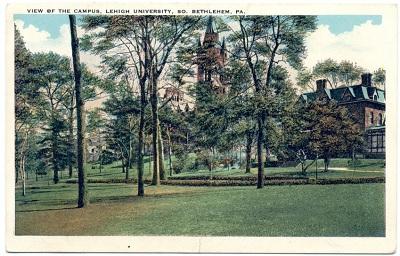
Architect: Edward T. Potter
Dates: c. 1866
Type: Residential
Defining the Lehigh Presidency
When Lehigh first opened its doors in 1865, the role of the University president was drastically different than it is today. Lehigh’s first president, Henry Coppée (1866-1875) was responsible for overseeing three main areas: administration, supervision and instruction. In 2014, President Alice Gast said that the first president of Lehigh “was like the head of a boarding school, with influence that was swift and direct.” In the early days, students were required to seek permission from the president in matters such as leaving the campus or missing mandatory church service. Aside from his role as chief supervisor, Coppée’s administrative duties included the oversight of university property, taking the lead in admissions decisions, and acting as the chief representative of Lehigh. Instructionally, Coppée prepared the Register, which is now known as the course catalog and served as a professor of literature. Coppée’s tenure defined the role of the president, but key developments during the leadership of his successors, John McDowell Leavitt (1875-1880) and Robert Alexander Lamberton (1880-1893), would shape the office into something closer to the president’s role at Lehigh today.
As Lehigh’s second president, Leavitt sought to increase the size of the student body, a goal that would put the president at odds with the faculty. Asserting his right as president to make admissions decisions, Leavitt upset the faculty by admitting students that did not meet their standards. In a move that threatened Leavitt’s role as chief administrator, the faculty passed a motion which stated that they did not recognize the president’s right to determine admittance decisions without their input. The feud essentially ended the president’s role in making admissions decisions and created a rift between the faculty and the administration that would continue for decades. This separation between the faculty and the administration was apparent during the tenure of Lamberton, Lehigh’s third president. Lamberton was the first University president who was not an instructor, and many of the matters surrounding academics and instruction were therefore left to the faculty. Additionally, Lamberton recognized the faculty’s role in admissions, allowing them to modify the entrance examination from 1881-1888, which reduced the administrative power of the office Lamberton held.
Today, the president focuses on administration but also has a more modern obligation, which is to represent the University as well as its goals and values to the external community. In order to accomplish this, each of the most recent presidents has offered a distinct vision for Lehigh’s future. For instance, President Gregory Farrington (1998-2006) sought to fine-tune Lehigh’s national and international image. A 1998 Brown and White article stated that Farrington “welcomes the challenge of encouraging and sustaining academic excellence as his first priority.” “I want to see in a decade, even more students look at offers from competitive colleges and say, ‘I was accepted at three Ivies, as well as Lafayette and Lehigh, and of course I went to Lehigh.’” President Gast (2006-2014) was more focused on expanding both graduate and undergraduate research opportunities. During her tenure, Gast worked to greatly expand the facilities on the Mountaintop campus, seeking to provide new educational experiences that would strengthen Lehigh’s reputation as a first class, private research institution.
As each of the latest presidents has been focused on representing the University as a whole, the emphasis on instruction seen in early presidents has been eliminated completely. However, President Gast said that the office still “has ultimate authority on academic matters.” Vice Provost for student affairs John Smeaton described Lehigh’s current administrative organization as a hybrid, two-part model, consisting of the President and the Provost. The president is more concerned with matters such as external advocacy, fundraising, and accreditation. Smeaton compared the President to the CEO of a company, while the Provost is more like the COO.
John Smeaton attributed the changing role of the president to a changing campus environment. Of course, the size and scale of the University has greatly changed. Smeaton said that “in the early 20th century, education was the domain of the affluent. In the last 50 years, it has become more egalitarian.” He also attributed some of the growth and complexity of the administration to more government regulations. Since the 1960s, state and federal laws that affect Lehigh’s operations have greatly increased, and the size of the administration has grown as a result. With a larger administration, the University president no longer needs to manage such matters directly. Overall, it is clear that the role of the president has changed greatly since 1865, and as Lehigh continues to expand and reshape, the presidency will undoubtedly evolve as well.
Text by David Canfield '14 and Carl Tischbein '16
This image illustrates just how involved the President was involved in the students' day-to day lives - students were required to submit this card to the President if they could not attend the mand
Still Looking for You
Lehigh University
Bethlehem, PA 18015

27 Memorial Drive West, Bethlehem, PA 18015
